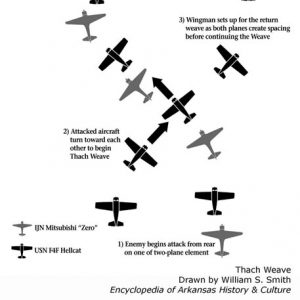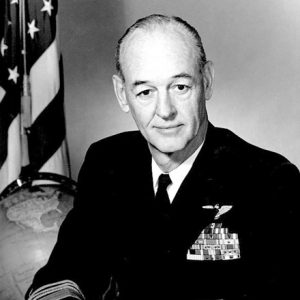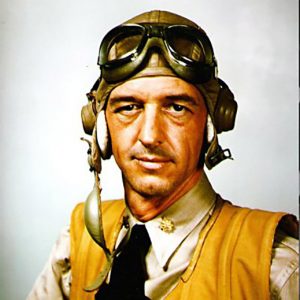calsfoundation@cals.org
John Smith (Jimmie) Thach (1905–1981)
John Smith (Jimmie) Thach was one of the most influential naval aviators of the mid-twentieth century and is credited with the creation of the Thach Weave, one of the most significant tactical advances in the history of aerial combat. He was awarded the Navy Cross and Distinguished Service Medal for developing this tactical maneuver, which remains a standard of military aviation.
Jimmie Thach was born on April 19, 1905, in Pine Bluff (Jefferson County) to schoolteachers James H. Thach and Jo Bocage Thach. He grew up in Fordyce (Dallas County). Thach followed in the footsteps of his brother James Jr. (who also rose to the rank of admiral) and attended the United States Naval Academy. After his graduation in 1927, he took the traditional career path of the period by serving on battleships. He was assigned to the battleships Mississippi, then the California before transferring to the fledgling area of aviation in 1929.
Earning his naval aviator’s wings in 1930, Thach quickly built a reputation as one of the most skilled aviators in the pre–World War II U.S. Navy. As a member of Fighting One, known as the “High Hats” for their logo, a tuxedo-style high hat, Thach and his squadron performed stunt work for Clark Gable’s 1931 movie Hell Divers. Thach also set endurance records during the period with experimental aircraft, notably piloting an XP2H seaplane from Norfolk, Virginia, to Panama in less than twenty-six hours.
Despite records and momentary fame, the pinnacle of Thach’s tactical career came after the outbreak of World War II. Having achieved test-pilot status and serving as the commander of Fighting Three squadron, Thach’s “Felix the Cat” unit was equipped with aircraft that could not match the performance standard set by the latest Japanese fighter airplane, the Mitsubishi A6M Reisen (commonly referred to as the Zero). With access to intelligence reports on the maneuverability and range of the Zeros, Thach began to work with fellow VF-3 pilot, Edward J. “Butch” O’Hare, on a new paradigm for naval aviation tactics.
Abandoning the American tradition of a three-aircraft element, Thach considered a two-plane system. His “beam defense position” system created mutual support in the event of attack. Flying side-by-side in what has become known as combat spread, the pilots would begin to weave back and forth when under attack. The simple act of turning away allowed the aircraft under attack to reduce its exposure by becoming a diminishing target while drawing the attacker into the line-of-fire of the wingman. If the aggressor persisted, when the two planes crossed over in the weave, it resulted in a high percentage opportunity for response from the aircraft not under attack.
While utilized infrequently by other units around the world, the maneuver had its first disciplined test at the Battle of the Coral Sea in May 1942, when a number of his squadron’s pilots were temporarily assigned to the carrier USS Lexington. These pilots used the weave to down nineteen of twenty Japanese fighters attacking the Lexington. However, it was the widespread employment of the maneuver at the Battle of Midway, June 3–7, 1942, by planes flying from the Yorktown with similar positive results for the U.S. Navy, which established the legend of the Thach Weave.
With his tactical skill deemed too valuable to risk at sea, Thach was transferred to Jacksonville, Florida, to teach combat tactics and create training films that became the standard for a generation of naval aviators. At the close of World War II, Commander Thach returned to the Pacific as the operations officer to Vice Admiral John McCain’s fast carrier task force and was present at the formal Japanese surrender on September 2, 1945.
Promoted to captain after the war, he became deeply involved in the political battle to preserve the aircraft carrier as part of the U.S. Navy during the postwar reductions in force. He commanded the carrier Sicily during the Korean conflict and provided another footnote to aviation history as the commander of an operation to capture a Soviet-designed MiG-15 for intelligence study. The Pinch-a-MiG operation on July 9–10, 1950, resulted in the sinking of a former Soviet submarine in service of the North Korean Navy. Thach’s final ship command came with the Franklin D. Roosevelt on a six-month tour in the Mediterranean.
Promoted to rear admiral in 1955, he evolved as a fleet officer into one of the navy’s top antisubmarine warfare experts and advocate of nuclear power. Today, in recognition of his career, the Admiral Thach Award is annually presented to the most outstanding antisubmarine warfare squadron.
Moving into staff duty at the Pentagon as deputy chief of naval operation for air, he achieved, in the early 1960s, the adoption of the A-7 Corsair II for carrier use—which meant that the Navy had a medium bomber that suited carrier operations—over the objections of Secretary of Defense Robert McNamara, who advocated the standardization of the services and using one model of aircraft for all branches of the military. He finished his forty-year career in 1967 as the commander in chief of U.S. naval forces in Europe. He and his brother James are among a handful of naval officers to simultaneously serve as full admirals on active duty.
Thach died in Coronado, California, on April 15, 1981, and the guided missile frigate USS Thach was commissioned in his honor in 1984. Thach was inducted into the Arkansas Aviation Hall of Fame in 1981.
For additional information:
Ewing, Steve. Thach Weave: The Life of Jimmie Thach. Annapolis, MD: Naval Institute Press, 2004.
“The Goblin Killers.” Time 72 (September 1, 1958): 9–15.
Thach, John Smith. Reminiscences of Admiral John Smith Thach, U.S. Navy (Retired). Annapolis, MD: U.S. Naval Institute, 1977.
William M. Smith
Fayetteville, Arkansas
This entry, originally published in Arkansas Biography: A Collection of Notable Lives, appears in the CALS Encyclopedia of Arkansas in an altered form. Arkansas Biography is available from the University of Arkansas Press.









What is so impressive to me is that once aware of the “Weave,” the Japanese immediately recognized the extreme risk the tactic could (and would) be to their entire war strategy and they spent many months attempting to come up with an effective counter to this, yet never did. I have yet to read the first book written in 2004 about this incredible hero’s life and I cannot wait to learn more. His Weave had to be built on careful execution of the strategy and unfailing trust of one’s wingman – since by definition each of the pair would be vulnerable for significant stretches. And we hear that Lt. (later Full Admiral) “Jimmy” Thatch began this ingenious strategy on a dinner napkin sketch one evening. Don’t yet know if that is true but pure genius and inspiration and a credit to his nation. What a guy he was. I so wish I could have met him.